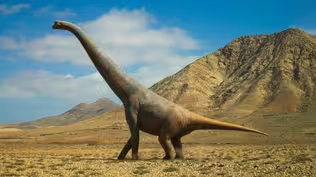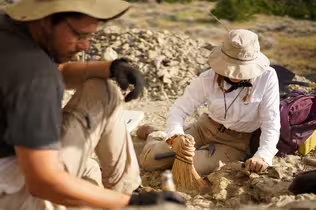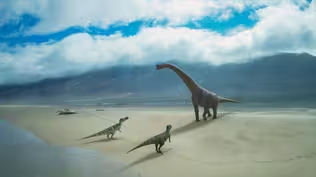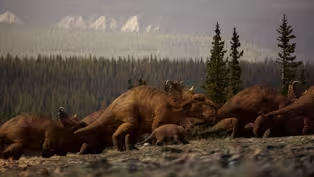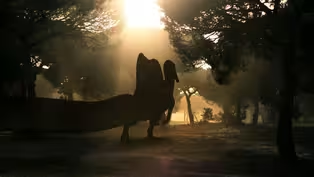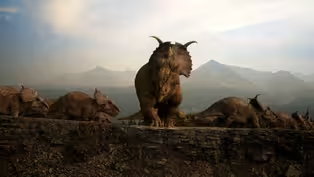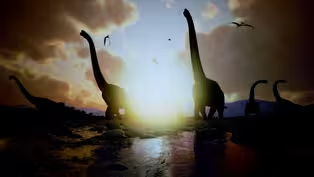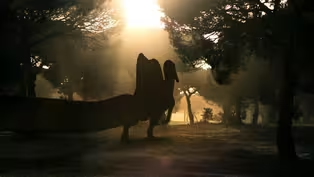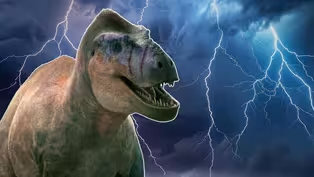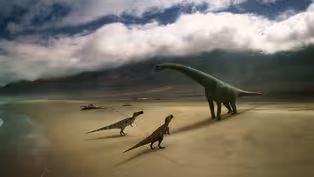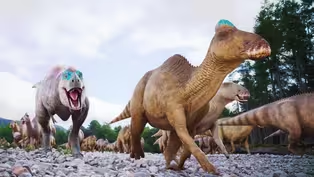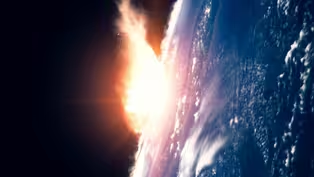
How to Find a Dinosaur that Hollywood Dreamed Up
Special | 5m 50sVideo has Closed Captions
What would make a Utahraptor so much larger than other raptor species?
Paleontologist Jim Kirkland believed that some raptors could have grown to the size of those seen in cinemas… but all he had to go on was a single claw. After years searching in the Utah desert, a rock the weight of a school bus appeared to contain the bones of a giant creature - Utahraptor. But what conditions would be needed to allow a creature like this to grow so much larger?
Problems playing video? | Closed Captioning Feedback
Problems playing video? | Closed Captioning Feedback
Narrator: Bertie Carvel With Thanks: Utah State University, Usu Eastern Prehistoric Museum, Utah Geological Survey, Bureau of Land Management Utah, Moab Field Office, Utah Dig Team Digital Producer & Director:...

How to Find a Dinosaur that Hollywood Dreamed Up
Special | 5m 50sVideo has Closed Captions
Paleontologist Jim Kirkland believed that some raptors could have grown to the size of those seen in cinemas… but all he had to go on was a single claw. After years searching in the Utah desert, a rock the weight of a school bus appeared to contain the bones of a giant creature - Utahraptor. But what conditions would be needed to allow a creature like this to grow so much larger?
Problems playing video? | Closed Captioning Feedback
How to Watch Walking with Dinosaurs
Walking with Dinosaurs is available to stream on pbs.org and the free PBS App, available on iPhone, Apple TV, Android TV, Android smartphones, Amazon Fire TV, Amazon Fire Tablet, Roku, Samsung Smart TV, and Vizio.
Providing Support for PBS.org
Learn Moreabout PBS online sponsorshipMore from This Collection
Check out our 12 digital exclusives from our series Walking with Dinosaurs with BBC.
When Dinosaurs Ruled the Arctic Circle
Video has Closed Captions
Very few dinosaurs made it as far North as the Arctic Circle...except for two. (5m 52s)
We Were Wrong About Spinosaurus
Video has Closed Captions
Millions of years ago, dinosaurs ruled the Earth. But underwater it was a totally different world. (6m 36s)
Were Dinosaur Brains Designed For Combat?
Video has Closed Captions
Did Pachyrhinosaurus bones always gather in such great numbers? (5m 42s)
How We Solve Jurassic Mysteries from One Bizarre Fossil
Video has Closed Captions
Would you lick a 65-million-year old dinosaur poop? (5m 19s)
How Walking with Dinosaurs Created the Most Accurate Dinos Ever
Video has Closed Captions
Join the team behind the scenes! (6m 32s)
How the Walking with Dinosaurs Team Brought a Dinosaur Back to Life
Video has Closed Captions
The Walking With Dinosaurs team reveal how they created the Spinosaurus. (5m 50s)
How Extreme Weather Is Revealing — And Destroying — Dinosaur Fossils
Video has Closed Captions
Imagine finding a rare fossil that you’ve been desperate to find - only for it to be put at risk. (5m 59s)
How an Evolutionary Arms Race Created Bizarre Dino Designs
Video has Closed Captions
It’s grudge match time. Except that this one took place over millions of years. (5m 32s)
The Dinosaurs that Could Cross the Atlantic
Video has Closed Captions
How did dinosaur fossils get there? (5m 42s)
Did Dinosaurs Abandon Their Young to Help Them Survive?
Video has Closed Captions
In late Cretaceous Alberta, many apex predators roamed free, so how did the prey survive? (5m 45s)
Did a Meteor Kill All the Dinosaurs?
Video has Closed Captions
Did the asteroid kill the T. rex and Triceratops? (5m 42s)
Providing Support for PBS.org
Learn Moreabout PBS online sponsorship[chitters] [thrilling music] -[Narrator] Utahraptor is the largest species of raptor that ever lived.
[rasping screeches] [intense music] But until relatively recently, no-one knew this fearsome predator even existed.
[heavy footsteps] [sharp, piercing call] [gentle music] In the early 1990s, paleontologist Jim Kirkland was working in the Utah desert.
When his team discovered a huge claw belonging to an unknown dinosaur.
-[Jim Kirkland] Well when I first saw this claw, you know I got real excited, we need to find more of this animal.
This is something new and it is huge.
-[Narrator] Jim thought it might belong to a new species of raptor.
[blows] But to be sure, he needed more evidence.
Then in 2005, he got the lucky break he needed.
-[Jim] A geology student reported some dinosaur bones coming out of the base of a cliff.
And we went out and excavated, we found it was such a dense accumulation of bones you couldn’t put an icepick in without hitting something.
[clanking] -[Narrator] So many bones so close together meant the team had to take them all out in one huge slab.
-[Jim] We ended up having a nine-ton block filled with skeletons.
-[Narrator] After nearly a decade of excavation, they finally got it back to the lab.
-[Jim] Lift.
And fold.
-[Narrator] And could begin to uncover what was inside.
-[Jim] There’s, uh, more therapod material than anything I’ve ever seen.
Yeah, this thing, you know, at least 95% meat-eating dinosaur bones.
-[Narrator] The first bones to emerge all belonged to small dinosaurs.
-[Jim] Okay.
-[Narrator] But deeper into the rock, the team began to find much larger bones.
-[Jim] We pulled a big tibia out of there with the ankle in place, we have part of an adult tail here, more of the base of the tail right there.
Have a big adult animal.
And those bones are stout and massive.
-[Narrator] Jim had finally found the dinosaur his mysterious claw belonged to.
-[Jim] So this thing is built like Arnold Schwarzenegger, it’s anchoring massive muscles with long blades on their feet and hooked raptorial claws on their hands.
[rasping screeches] -[Narrator] Utahraptor, the size of a grizzly bear.
But with most raptors the size of a turkey, how did Utahraptor get so big?
Jim thinks the answer could be linked to a little known extinction event at the end of the Jurassic.
-We’re putting together a new story that shows a major extinction in Earth history that hadn’t really been recognized before.
We lose three major groups of large predatory dinosaurs, the kings of their creation, they all go extinct.
-[Narrator] For reasons no one fully understands, [snarls] big carnivores like Torvosaurus and Allosaurus completely disappear from this part of North America.
-Other animals do survive elsewhere but in this region we have nothing.
It’s almost a total wipeout.
-[Narrator] But the extinction of one species creates opportunities for the survivors.
With all the large predators gone, there was a gap at the top of the food chain.
-My baby.
-[Narrator] And over millions of years, Utahraptor evolved to take over.
-[Jim] There’s this niche open, you know, where no-one is filling it, these things just got real big to take advantage of the hole in the landscape.
-[Narrator] Transforming into a new and terrifying top predator.
-[Jim] The Utahraptor liked to stalk in the brush where the prey had no clue they’re there till they were in striking distance.
And as soon as they did it, it would flex open its arms, you know, and leap screaming at its prey, it would happen so quick when you look at a lion attack or leopard attack, bam they’re on it.
-[Utahraptor screeches] -[Gastonia grunts] And that’s how Utahraptor would be too.
-[Narrator] A fortuitous find in the desert and an evolutionary lucky break gave us the largest raptor that’s ever lived.
[heavy footsteps]

- Science and Nature

Explore scientific discoveries on television's most acclaimed science documentary series.

- Science and Nature

Capturing the splendor of the natural world, from the African plains to the Antarctic ice.












Support for PBS provided by:
Narrator: Bertie Carvel With Thanks: Utah State University, Usu Eastern Prehistoric Museum, Utah Geological Survey, Bureau of Land Management Utah, Moab Field Office, Utah Dig Team Digital Producer & Director:...

